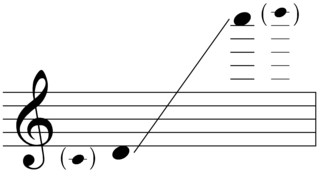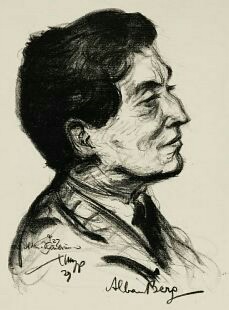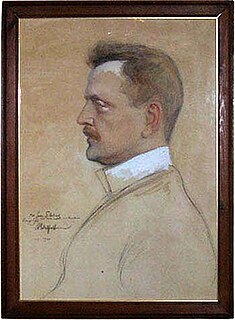Symphony No. 6 by Russian composer Alfred Schnittke was composed in 1992. It was commissioned by cellist and conductor Mstislav Rostropovich and the National Symphony Orchestra of Washington, who together gave its first performance in Moscow on 25 September 1993. [1]

Alfred Garrievich Schnittke was a Soviet and German composer. Schnittke's early music shows the strong influence of Dmitri Shostakovich. He developed a polystylistic technique in works such as the epic Symphony No. 1 (1969–1972) and his first concerto grosso (1977). In the 1980s, Schnittke's music began to become more widely known abroad with the publication of his second (1980) and third (1983) string quartets and the String Trio (1985); the ballet Peer Gynt (1985–1987); the third (1981), fourth (1984), and fifth (1988) symphonies; and the viola concerto (1985) and first cello concerto (1985–1986). As his health deteriorated, Schnittke's music started to abandon much of the extroversion of his polystylism and retreated into a more withdrawn, bleak style.

Mstislav Leopoldovich "Slava" Rostropovich was a Soviet and Russian cellist and conductor. He is considered to be one of the greatest cellists of the 20th century. In addition to his interpretations and technique, he was well known for both inspiring and commissioning new works, which enlarged the cello repertoire more than any cellist before or since. He inspired and premiered over 100 pieces, forming long-standing friendships and artistic partnerships with composers including Dmitri Shostakovich, Sergei Prokofiev, Henri Dutilleux, Witold Lutosławski, Olivier Messiaen, Luciano Berio, Krzysztof Penderecki, Alfred Schnittke, Norbert Moret, Andreas Makris, Leonard Bernstein and Benjamin Britten.

The National Symphony Orchestra (NSO), founded in 1931, is an American symphony orchestra based in Washington, D.C.. Its principal performing venue is the John F. Kennedy Center for the Performing Arts.
The symphony is scored for an orchestra of:
3 flutes (nos. 2 and 3 doubling piccolo), 3 oboes (no. 3 doubling cor anglais), 4 clarinets (no. 3 doubling bass clarinet, no. 4 doubling clarinet in E♭), 3 bassoons (no. 3 doubling contrabassoon), 4 horns, 4 trumpets, 4 trombones, tuba, timpani, percussion (2 players), harp, piano, and strings.

The Western concert flute is a transverse (side-blown) woodwind instrument made of metal or wood. It is the most common variant of the flute. A musician who plays the flute is called a flautist, flutist, flute player, or (rarely) fluter.

The piccolo is a half-size flute, and a member of the woodwind family of musical instruments. The modern piccolo has most of the same fingerings as its larger sibling, the standard transverse flute, but the sound it produces is an octave higher than written. This gave rise to the name ottavino, which the instrument is called in the scores of Italian composers. It is also called flauto piccolo or flautino.

Oboes belong to the classification of double reed woodwind instruments. Oboes are usually made of wood, but there are also oboes made of synthetic materials. The most common oboe plays in the treble or soprano range. A soprano oboe measures roughly 65 cm long, with metal keys, a conical bore and a flared bell. Sound is produced by blowing into the reed at a sufficient air pressure, causing it to vibrate with the air column. The distinctive tone is versatile and has been described as "bright". When the word oboe is used alone, it is generally taken to mean the treble instrument rather than other instruments of the family, such as the bass oboe, the cor anglais, or oboe d'amore
The movements are as follows:
The playing time is approximately 35 minutes.
The composition of the symphony coincided with Schnittke's work on the orchestration of the first two acts of his opera Historia von D. Johann Fausten. Hence there are similarities between the instrumentation and thematic material of both. Following performances in the United States in 1994 Schnittke made changes to the score, reducing the number of silent bars and making minor alterations to the orchestration. [2]

Historia von D. Johann Fausten is an opera by the Russian composer Alfred Schnittke (1934–1998) in three acts, with introduction and epilogue to the German libretto by Jörg Morgener and Alfred Schnittke after the anonymous prose book of the same name.
The first movement opens with a built up chord which shatters into fragments from which themes on viola and then on trombones emerge, the latter stating a chorale-like theme reminiscent of Bruckner. The fragments gradually come together before collapsing again. Stabbing motifs intervene which become more agitated until the opening chord returns to bring the movement to a close.
The second movement is effectively a scherzo. Beginning with echoes of the stabbing motif from the first movement it features prominent roles for the four trumpets and contains references to Shostakovich's fourth and sixth symphonies.
A scherzo, in western classical music, is a short composition – sometimes a movement from a larger work such as a symphony or a sonata. The precise definition has varied over the years, but scherzo often refers to a movement that replaces the minuet as the third movement in a four-movement work, such as a symphony, sonata, or string quartet. The term can also refer to a fast-moving humorous composition that may or may not be part of a larger work.
Dmitri Shostakovich composed his Symphony No. 4 in C minor, Opus 43, between September 1935 and May 1936, after abandoning some preliminary sketch material. In January 1936, halfway through this period, Pravda—under direct orders from Joseph Stalin—published an editorial "Muddle Instead of Music" that denounced the composer and targeted his opera Lady Macbeth of Mtsensk. Despite this attack, and despite the oppressive political climate of the time, Shostakovich completed the symphony and planned its premiere for December 1936 in Leningrad. After rehearsals began, the orchestra's management cancelled the performance, offering a statement that Shostakovich had withdrawn the work. He may have agreed to withdraw it to relieve orchestra officials of responsibility. The symphony was premiered on 30 December 1961 by the Moscow Philharmonic Orchestra led by Kirill Kondrashin.
The Symphony No. 6 in B minor, Op. 54 by Dmitri Shostakovich was written in 1939, and first performed in Leningrad on 21 November 1939 by the Leningrad Philharmonic Orchestra under Yevgeny Mravinsky.
The Adagio is based on a 12 note tone row, first heard on the strings, whose harmony consists in permutations of itself. The bass clarinet, supported by two bassoons, picks out four notes from the tone row in a reference to the overture to Wagner's Tristan and Isolde. As the movement comes to a conclusion one of the more sombre permutations of the tone row becomes prominent and the movement concludes in an atmosphere of pathos.
In music, a tone row or note row, also series or set, is a non-repetitive ordering of a set of pitch-classes, typically of the twelve notes in musical set theory of the chromatic scale, though both larger and smaller sets are sometimes found.
The final movement continues on from the third without a break (i.e. attacca). As with other pieces by Schnittke (for instance the fourth violin concerto) the finale draws upon the previous three movements for much of its material. It begins with a persistent four note motif to which previous themes, less fragmented than previously, are joined suggesting the unity of the symphony as a whole. The stabbing motif from the second movement returns. It is joined by a more urgent version of the four note motif from the beginning of the finale, together driving the music towards a climax in which the themes again shatter into fragments from which the tolling of a bell emerges to end the symphony.






